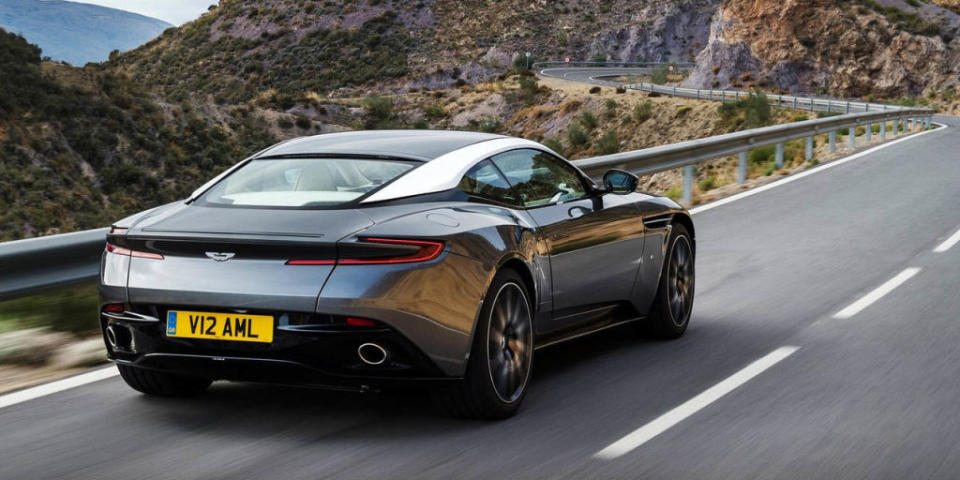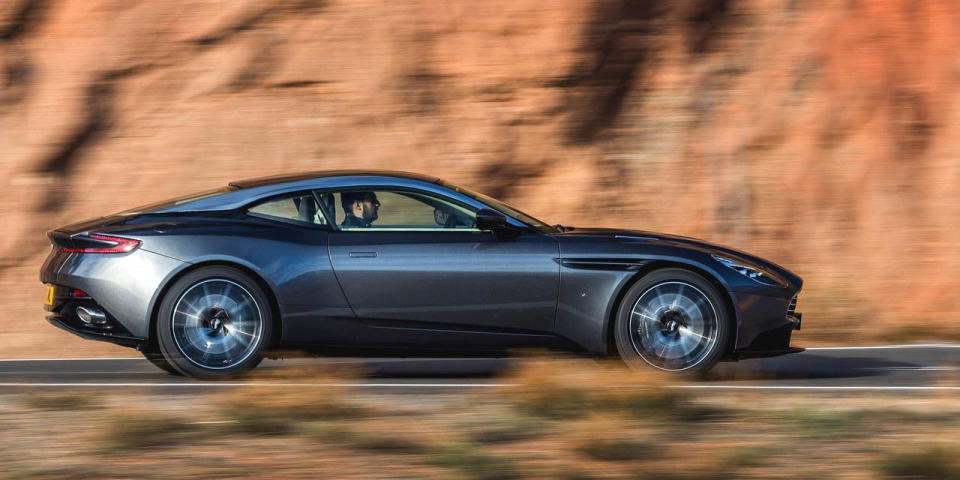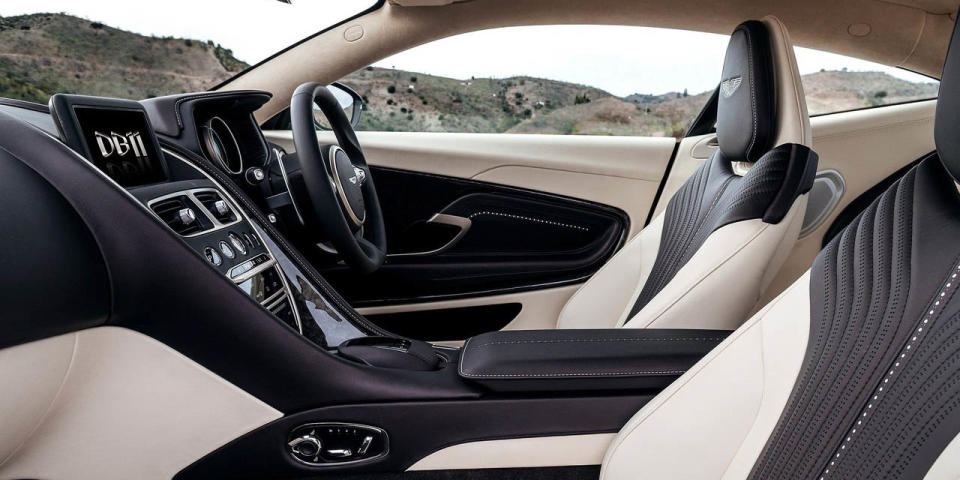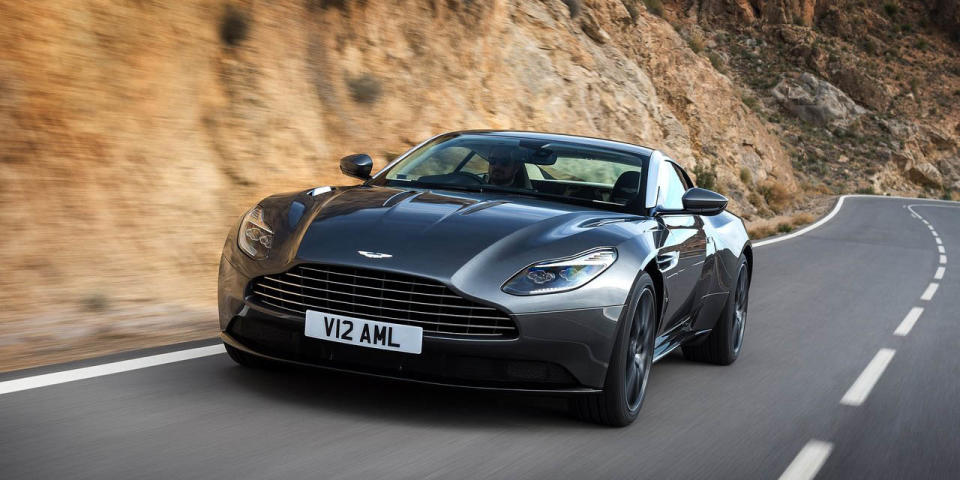Aston Martin DB11: First Drive

It's missing.
The fly-off handbrake, tucked between the driver's seat and door, the same location on every Aston Martin DB car since 1955, is gone. Missing, too, are the classic analog gauges, replaced by a digital instrument cluster from Mercedes. The engine fires via push button, not the usual cassette-style, key-in-dash ignition. Thirty seconds after climbing into the DB11, it's clear this isn't just a new car, but a break from tradition. And that's cause for concern.
After all, tradition is Aston Martin's proverbial trump card. Ferraris are faster. Lamborghinis are edgier. But if you're abstaining from progress, only something from Gaydon will do. Nowhere else can you get a rear-drive V12 with a dogleg manual, let alone one with bodywork and interior set by hand. These are the sure signs of the British, a people who champion endurance. It's also indicative of a company that's been profitable only twice in its 103-year history.
Still, times change. Competition grows fiercer, regulations more stringent. We live in a world that doesn't differentiate "tradition" from "stagnation." Churning out six-figure anachronisms, lovely as they may be, won't be sustainable much longer. But how do you modernize a product defined by its antiquity?

The DB11, which replaces the DB9, represents Aston's first attempt to answer this question. So the handbrake dies, Mercedes joins as a technical partner, and out rolls an all-new chassis, the brand's first in more than a decade. Modularity is key here, because these are the bones for the next-generation Vantage and Vanquish sports cars, a future crossover, and the battery-powered RapidE sedan. The plan is to double annual sales before 2020. Say what you will about CEO Andy Palmer, but the man's not lacking in ambition.
That sales volume means a carbon tub wasn't feasible, so the new structure is lightweight bonded aluminum, with larger door apertures and a slightly lower roofline. The DB11 is longer than the DB9, most notably in wheelbase, which grows 2.6 inches. Pulling bodywork in tight masks a substantially wider track, too. The shape is more masculine and angular, but the overall design remains fantastically clean. Aero devices, namely trick BMW i8–style ram air buttresses and a deployable rear Gurney flap, are all cleverly concealed. Proportions scream two-plus-two grand tourer-the decklid is comically short, and designers claim the DB11's reverse-hinged hood is the largest single-piece clamshell in production.
Tip it forward, and you'll find Aston's new flagship V12. Like Aston's old flagship V12, it's an aluminum, 48-valve, quad-cam job built by Ford in Cologne, Germany. The block is slung front-mid, meaning it's tucked comfortably between the front axle and the firewall, with power running to the rear axle via an eight-speed ZF torque-converter transaxle.
Engineers claim this powertrain is 25 percent more efficient, due partly to cylinder deactivation and automated stop/start. Displacement falls from 5.9 to 5.2 liters, and, yes, there's now a pair of turbochargers. That twin-scroll swell defines the engine's character. Peak torque holds from 1500 to 5000 revs, while maximum output arrives at 6500 rpm, at redline. It feels prodigious and progressive. The sounds are pure imperial warship, a refined snarl with loads of induction noise. You do miss the mechanical honey of an all-motor V12 on the top end, which is more contrived bass than edgy baritone. This does not make the DB11's acceleration any less ferocious or addictive.
More interesting is what's been done to the damping and the electrically powered steering. The man behind both is chief vehicle engineer Matt Becker, formerly of Lotus. He's working with a new multilink rear suspension and a platform that's 15 percent stiffer than before. Except instead of stiffer springs, the DB11 goes the other way, with some of Aston's softest rates ever. That leaves Becker to conduct a symphony using the continuously variable Bilsteins. Dude's got chops.

Ride quality is spooky good. Like, Bentley good. The car floats over rough pavement, though the electric steering saps most of that texture through the wheel. In lieu of feedback, the DB11 employs a laughably quick rack, with a 13.0:1 ratio and 2.4 turns lock-to-lock. You get information through the weighting: light so the car doesn't feel jumpy off-center, noticeably lighter as it starts to push. There's body roll, but once it's settled, the Bridge-stones bite hard. It's a clever cocktail, the right amount of compliance and agility. The brake-based torque vectoring does wonders to hide the longer wheelbase once you're hustling, though Becker emphasizes it's only active above 0.80 g.
"We do not use it all the time," he said, "because this is a GT car."
That much is clear. The DB11 is a heavy car, and it can stress the front tires in a few miles of hard driving. Stability control is conservative at anything less than full-off. The iron-rotor brakes fade fast, and pedal feel is inconsistent. Carbon-ceramics might be optional later, but the luggage set that's already offered is more appropriate. This is a far cry from the frenetic, tire-smoking bullwhip that was the DB9. The DB11 seems aimed squarely at touring, with occasional B-road romps. When I posed this to Palmer, he nodded.
"One goal here is to differentiate the model range," he said. "This is a different customer to the Vantage. And, yes, that Vantage customer is more likely to spend a weekend at the circuit."
So I went to Becker. The next Vantage, then, will be the stiff-riding, rainmaking, genuine article sports car? He just smiled. Engineers always smile when they've got one in the chamber.

The DB11 is a capable grand tourer, but, like most Astons, something you appreciate for what it is more than how it drives. Consider the painting process, which takes 50 to 100 hours. The body-in-white is broken up, and each panel is sprayed seven times, wet-on-wet. Each is then hung to dry at an identical angle, ensuring the grain of the paint remains consistent. The resulting metallic finish is soft to the touch. You want to swim in it.
Or the interior, which also demands 50 to 100 hours to complete. It contains approximately three pieces of plastic. Everything else is hides, trees, metals, glass, wool, or Alcantara. Rolls-Royce and Bentley upholster seats, but Aston hand-builds its own from scratch. One person assembles the base, fits the cushions, stuffs the bolsters. Each car also has its own seamstress. Singular. So there's variation in trimset and stitching, not due to error, but because this one's done by Tracy, and the other's done by Diane.
You're not supposed to build cars this way. Not anymore. In order to do so, Aston Martin has broken from tradition, namely downsizing and turbocharging its V12 and using Mercedes switchgear. Palmer says he'd actually consider outsourcing any component, save the chassis or V12, to a supplier. Hearing that, and driving the DB11, it's clear where the company is headed. Ferrari is ultimately about lap times; Lamborghini is the bastion of absurdity for absurdity's sake. Aston Martin is asserting itself as the modern torchbearer for coachbuilding. As the last relevant old world automaker still run by the British, that's the right thing to do.

 Yahoo Autos
Yahoo Autos 